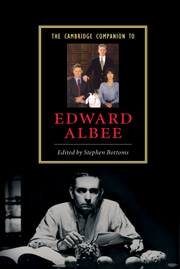Book contents
- Frontmatter
- 1 Introduction
- 2 Albee’s early one-act plays
- 3 Who’s Afraid of Virginia Woolf?
- 4 “Withered age and stale custom”
- 5 Albee’s 3½
- 6 Albee’s threnodies
- 7 Minding the play
- 8 Albee’s monster children
- 9 “Better alert than numb”
- 10 Albee stages Marriage Play
- 11 “Playing the cloud circuit”
- 12 Albee’s The Goat
- 13 “Words; words... They’re such a pleasure.” (An Afterword)
- 14 Borrowed time
- Notes on further reading
- Select bibliography
- Index
- Series List
7 - Minding the play
Thought and feeling in Albee’s “hermetic” works
Published online by Cambridge University Press: 28 May 2006
- Frontmatter
- 1 Introduction
- 2 Albee’s early one-act plays
- 3 Who’s Afraid of Virginia Woolf?
- 4 “Withered age and stale custom”
- 5 Albee’s 3½
- 6 Albee’s threnodies
- 7 Minding the play
- 8 Albee’s monster children
- 9 “Better alert than numb”
- 10 Albee stages Marriage Play
- 11 “Playing the cloud circuit”
- 12 Albee’s The Goat
- 13 “Words; words... They’re such a pleasure.” (An Afterword)
- 14 Borrowed time
- Notes on further reading
- Select bibliography
- Index
- Series List
Summary
Edward Albee has noted in his work a shift from greater to less transparency (or vice versa) from one play to the next. He has, he observes, a tendency to write from time to time in a “hermetic” fashion. Looking, as we now may, at a lifetime's work, the hermetic Albee stands out against the obviously engaged and accessible dramatist of Who's Afraid of Virginia Woolf? (1962) or Seascape (1975), as any playgoer or reader will easily recognize. If the distinction has latterly become less radical than it appeared with Box and Quotations from Chairman Mao Tse-Tung (1968) or, to a somewhat different degree of obscurity, Tiny Alice (1964), the hermetic tendency underlies some of the most interesting characteristics of Albee's dramaturgy.
There can be no doubting Albee’s deep critical involvement in both the understanding of his own work and also with wider issues concerning new writing and the contemporary American stage. This was most evident in the aftermath of the huge success of Who’s Afraid of Virginia Woolf? (1962). Albee, lately the Young American Playwright, now the Famous American Playwright, lacked no opportunity to convey his views in numerous interviews, one notable press conference, and also the contextual writings accompanying editions of his work. This was also a period in which he came to know personally some seminal figures in playwriting – notably Pinter and Beckett. The latter has remained a significant point of reference in Albee’s thinking and, it may be hazarded, in his work.
- Type
- Chapter
- Information
- The Cambridge Companion to Edward Albee , pp. 108 - 126Publisher: Cambridge University PressPrint publication year: 2005

